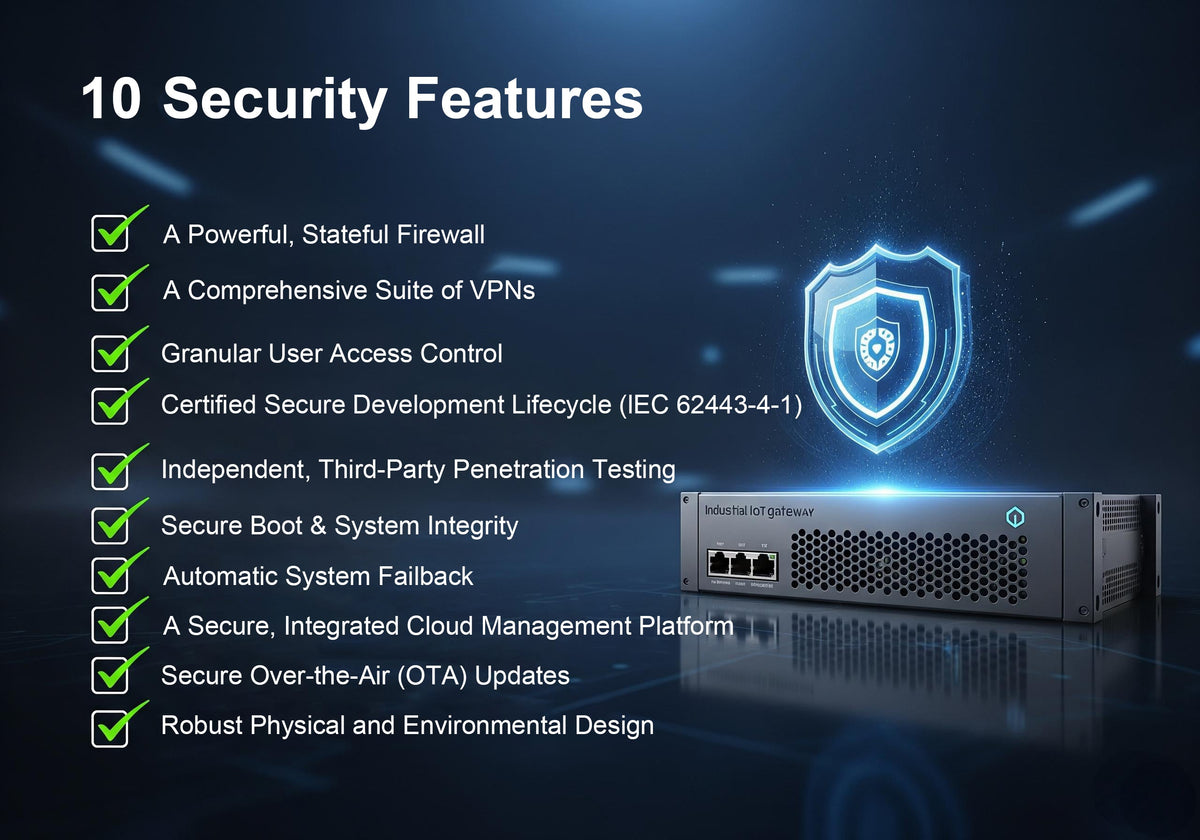
10 Security Features You Need in an Industrial IoT Edge Gateway OS
|
|
Time to read 6 min
|
|
Time to read 6 min
In the world of Industrial IoT, connectivity is king, but IoT gateway security is the foundation of the entire kingdom. A single vulnerability in your edge gateway's operating system can expose your entire OT network to catastrophic risks.
This guide dives into the 10 essential IoT gateway security features you must demand from your device's OS. We'll move beyond basic password protection and explore critical elements like certified secure development, hardware-level security, robust VPNs, and system resilience.
Understand what truly makes an industrial OS secure and how platforms like Robustel's RobustOS Pro are built to protect your most critical assets.
I've seen it happen too many times: a company invests heavily in a brilliant IoT solution, only to have it compromised because the security of the operating system on their IoT Edge Gateway Device was an afterthought. An IoT Gateway isn't just another IT device; it's a bridge that directly connects your sensitive factory floor (OT) to the wider world (IT). If that bridge isn't secure, it becomes a wide-open door for threats.
Many people think a simple firewall is enough. But in today's landscape of sophisticated cyberattacks, that's like putting a standard door lock on a bank vault. A truly secure Industrial IoT Edge Gateway requires a hardened operating system with multiple, overlapping layers of defense. So, what should you be looking for? Let's break down the 10 critical IoT gateway security features.
Virtual Private Networks (VPNs) are essential for creating secure, encrypted tunnels for remote access and data backhaul. Your gateway's OS should support modern, secure VPN protocols.
IPsec: A highly secure and widely adopted standard for site-to-site connections.
OpenVPN: A flexible and popular open-source option.
Wireguard: A modern, fast, and lean VPN protocol that is rapidly gaining popularity for its performance and simplicity. Support for multiple VPNs gives you the flexibility to connect all your IoT Edge Gateways securely to any corporate network or cloud platform.
Who has access to your gateway? A secure OS allows you to create different user roles with different privilege levels. This means a field technician might only have access to basic diagnostic information, while a senior administrator has full configuration rights. This principle of least privilege is a core tenet of cybersecurity.
A vendor can claim their OS is secure, but has it been proven against real-world attacks? A key trust signal is regular, independent penetration testing by reputable cybersecurity firms. For example, Robustel's systems undergo annual penetration testing by experts, providing third-party validation that the OS can withstand sophisticated threats.

What happens if a remote firmware update is interrupted by a power failure? On a less robust system, the device could be "bricked," requiring a costly site visit. A key reliability feature of a hardened OS like RobustOS Pro is Automatic System Failback . It uses a dual-partition system; if an update fails, the OS automatically rolls back to the previous stable version, ensuring the gateway remains operational. This is a crucial feature for any unattended IoT Gateway.
Managing the security of one gateway is one thing; managing a fleet of thousands is another. A secure OS must integrate seamlessly with a centralized cloud management platform like Robustel's RCMS . The platform itself must be secure, offering:
Encrypted Communication: All communication between the gateway and the cloud must be encrypted.
Role-Based Access Control (RBAC): To control who can view or manage which devices.
Comprehensive Audit Logs: To track all actions performed on your fleet of IoT Gateways .
While technically hardware, the OS must be able to function on hardware built for the environment. An OS designed to run on a gateway with a fanless, aluminum alloy housing and a wide operating temperature range (e.g., -40°C to +70°C) is inherently more reliable.

True IoT gateway security is not a single feature; it's a multi-layered strategy that starts with the hardware, is built into the operating system, and extends to the cloud management platform. When selecting an Edge Gateway for your industrial project, don't just look at the specs. Ask the hard questions: Is the OS development process certified? Is it penetration tested? Does it have built-in reliability features like system failback? Choosing a gateway with a true hardened OS is the most important investment you can make in the long-term success and security of your IoT deployment.
A1: While all are important, a certified secure development lifecycle (like IEC 62443-4-1) is arguably the most critical foundational feature. It indicates that security is a systematic process for the vendor, not just a list of features added on later.
A2: A VPN creates a private, encrypted tunnel over the public internet. When your gateway sends data to your cloud server, the VPN ensures that even if the data is intercepted, it cannot be read. It's like sending your data in a locked, armored truck instead of an open postcard.
A3: A standard Debian installation requires significant manual hardening to be secure enough for industrial use. However, a commercial hardened OS like Robustel's RobustOS Pro takes the stable, flexible foundation of Debian and adds industrial-grade security layers, reliability features, and professional support, making it an excellent choice for your IoT Edge Gateway Device .